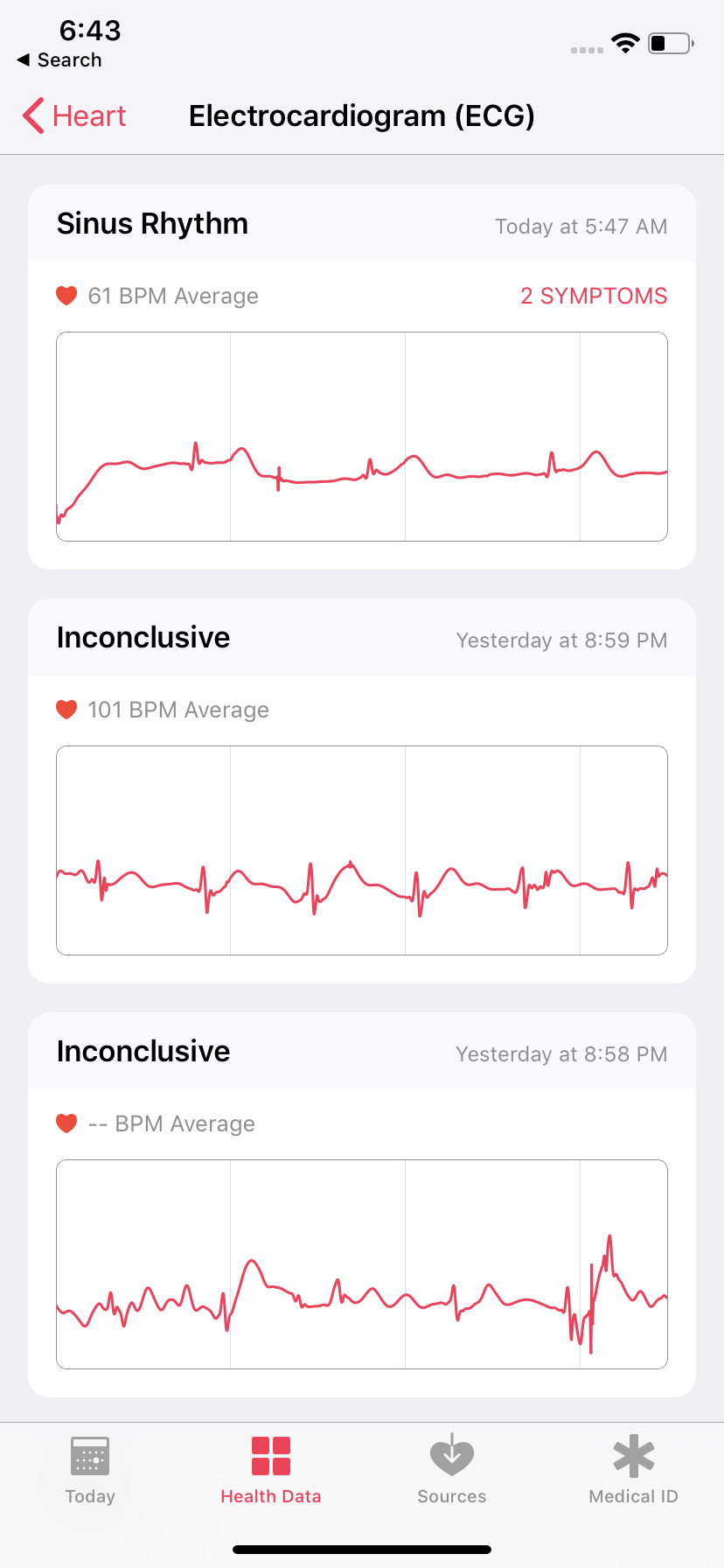Technology
Hands on with Apple Watch’s ECG and irregular heart rhythm features

The Apple Watch Series 4’s transformation from miniature iPhone and fitness tracker to medical device is now complete with the release of the ECG (electrocardiogram) app and irregular heart rhythm notifications.
The two heart-related features were introduced at the revamped smartwatch’s debut in September and are now finally available via a software update.
The ECG app is exclusive to the Apple Watch Series 4 as electrocardiogram readings need the electrodes built into both the heart rate monitor on the backside and within the Digital Crown to create a reading.
The irregular heart rhythm notifications (IHR) feature, however, only uses the optical heart rate sensor, and is therefore compatible with all Apple Watches from Series 4 going back to Series 1 (not to be confused with the original Apple Watch which is technically “Series 0”).
Apple gave me a preview of the ECG app and irregular heart rhythm notifications feature pre-loaded onto a Series 4 loaner unit so I could see for myself how they worked.
Of course, I couldn’t properly test whether the features would be life-saving or not since my heart’s healthy. Still, having the two features accessible from my wrist fulfills the device’s promise as a wearable companion that’s got my back if I were to notice unusual symptoms or signs that could be related to heart problems.
The most important thing to understand about both new heart-related features is that they’re — Apple can’t stress this enough – not replacements for a doctor. Nor do they make the Apple Watch some kind of holy grail wearable capable of detecting if you’ve got a heart attack or stroke.
Rather, both Apple Watch features are there to detect signs of atrial fibrillation (AFib), an irregular beating of the heart. If an ECG reading shows an irregular heart beat pattern or the IHR notifications thinks something isn’t right, that’s a suggestion and gentle nudge to check in with your physician. They’re by no means a definitive diagnosis of any heart condition.
Making sure Apple Watch users understand what the ECG readings and IHR notifications do and don’t do and translating the complicated medical terminologies associated with heart issues was a top priority for Apple.
Apple makes it easy to understand what an ECG is with plain English.
Image: SCREENSHOT: RAYMOND WONG/MASHABLE
You should definitely read up on what everything means.
Image: SCREENSHOT: RAYMOND WONG/MASHABLE
Setting up both features happens within Apple’s Health app on iOS. In typical Apple fashion, it walks you through how to use the ECG app on your Apple Watch and explains in plain English terms like sinus rhythm and atrial fibrillation, and the various readouts for what they could possibly suggest.
Tapping on “learn more” link button expands each section with more details and at first I was tempted to tap through to quickly complete the setup, but I decided not to. Because why even bother turning these features on if you don’t care to understand how your heart works and what the readouts might mean? You owe it to yourself to read through the various setup sections if you care about your heart health.
Taking and understanding your ECG
Taking an ECG on an Apple Watch Series 4 is quite easy: simply launch the ECG app and place your finger on the Digital Crown and a 30-second timer will count down.
For the best results, you’ll want to make sure your Apple Watch is snug on your wrist so the crystal heart rate sensor on the back accurately detecting your pulse and also have your arm rested on a table.
It’s so easy!
Image: screenshot: raymond wong/mashable
Once finished, you’ll get one of four different results: sinus rhythm, atrial fibrillation, low or high heart rate, or inconclusive.
If your heart’s operating normally, it’ll likely get a sinus rhythm result indicating “the upper and lower chambers of your heart are beating in sync” according to the Health app.
An atrial fibrillation result suggests your heart’s beating irregularly could be a sign of arrhythmia and you should probably visit your physician to find out if it’s something more serious.
A low or high heart rate result happens when your heart rate is either under 50 BPM (beats per minute) or over 120 BPM. In these cases, the Apple Watch’s sensors simply can’t check for atrial fibrillation and Apple considers the reading “inconclusive.”
Inconclusive readouts simply mean they couldn’t be classified, and could have been from improperly taking the ECG (see recommended tips above). An inconclusive readout doesn’t mean nothing is wrong.
You shouldn’t take an ECG every day.
Image: screenshot: raymond wong/mashable
What an ECG will look like in the Health app on iOS.
Image: SCREENSHOT: RAYMOND WONG/MASHABLE
Regardless of what ECG result you get when you take it, again, it’s not definitive. Symptoms such as fatigue or shortness of breath or chest tightness could impact the result and as such, the ECG app gives you a list of symptom options to add to each reading. These are stored together with the detailed ECG charts within the Health app.
Also important to note: You shouldn’t take an ECG all the time. While it might be comforting to get an ECG daily, Apple doesn’t want to put people in a state of paranoia or panic; it should only be used if you have symptoms that you think might impact your heart rhythm. Moreover, taking too many ECGs can actually create more false positives and false negatives, leading to inaccurate results over time.

A PDF export of one of my ECG readings.
Image: raymond wong/mashable
ECG readings in the Health app are presented in a graph that Apple says is familiar to physicians. In my briefing on the ECG app, I got the sense Apple wants patients to build a closer relationship with their healthcare providers.
For example, the ability to export your ECG readout as PDF and send it to your doctor or print it out to show them during a visit isn’t common yet, but it might be in the future. It gives some control back to the patient, but at the same time allows both patient and doctor to have a more informed overview of the patient’s health.
That said — in maybe what’s now sounding like somewhat of an annoying reminder — the Apple Watch’s ECG readout is only a single-lead ECG as opposed to the 12-lead ECGs used by hospital or doctor’s offices. The latter looks at your heart rhythm from multiple views (one for each of the connected leads) and can detect heart attacks.
If the Apple Watch ECG shows AFib, the responsibility is on the individual to get it further checked on by a physician and perhaps take a more advanced ECG reading.

Irregular heart rhythm notifications work in the background and supports Series 1-4.
There’s not a whole lot to say about the irregular heart rhythm notifications since I couldn’t get any data on it from my test Apple Watch.
Unlike an ECG, IHR notifications work in the background and only send an alert “if an irregular rhythm is detected on five rhythm checks over a minimum of 65 minutes.”
It’s still really early days for the Apple Watch’s medical ambitions, but it’s already looking promising. The American Heart Association published a white paper of preclinical studies that took a look at the effectiveness of using an Apple Watch for ECGs and IHR notifications. The results suggest the smartwatch is highly accurate in detecting signs of AFib.
As the Apple Watch’s sensors improve, heart and medical readouts will only get better and more accurate.
ECG and IHR notifications doesn’t mean we don’t need doctors anymore. Rather, it’s like having a guardian on your wrist — you’ll be glad it’s there if anything bad happens.
Both features will be available in a software update for watchOS starting today.

!function(f,b,e,v,n,t,s){if(f.fbq)return;n=f.fbq=function(){n.callMethod?
n.callMethod.apply(n,arguments):n.queue.push(arguments)};if(!f._fbq)f._fbq=n;
n.push=n;n.loaded=!0;n.version=’2.0′;n.queue=[];t=b.createElement(e);t.async=!0;
t.src=v;s=b.getElementsByTagName(e)[0];s.parentNode.insertBefore(t,s)}(window,
document,’script’,’https://connect.facebook.net/en_US/fbevents.js’);
fbq(‘init’, ‘1453039084979896’);
if (window._geo == ‘GB’) {
fbq(‘init’, ‘322220058389212’);
}
if (window.mashKit) {
mashKit.gdpr.trackerFactory(function() {
fbq(‘track’, “PageView”);
}).render();
}
-

 Entertainment6 days ago
Entertainment6 days agoWordPress.org’s login page demands you pledge loyalty to pineapple pizza
-

 Entertainment7 days ago
Entertainment7 days agoRules for blocking or going no contact after a breakup
-

 Entertainment6 days ago
Entertainment6 days ago‘Mufasa: The Lion King’ review: Can Barry Jenkins break the Disney machine?
-

 Entertainment5 days ago
Entertainment5 days agoOpenAI’s plan to make ChatGPT the ‘everything app’ has never been more clear
-

 Entertainment4 days ago
Entertainment4 days ago‘The Last Showgirl’ review: Pamela Anderson leads a shattering ensemble as an aging burlesque entertainer
-

 Entertainment5 days ago
Entertainment5 days agoHow to watch NFL Christmas Gameday and Beyoncé halftime
-

 Entertainment4 days ago
Entertainment4 days agoPolyamorous influencer breakups: What happens when hypervisible relationships end
-

 Entertainment3 days ago
Entertainment3 days ago‘The Room Next Door’ review: Tilda Swinton and Julianne Moore are magnificent






















